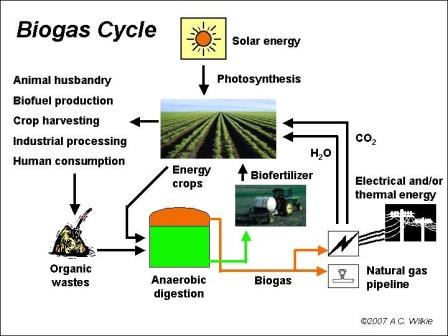Biogas Overview
Biogas: Biogas usually contains 45-70 % methane and 30-45 % carbon dioxide. Depending on the source, biogas can also contain, e.g., nitrogen, hydrogen sulfide, halogenated compounds and organic silicon compounds [1].
Biogas production: Biogas originates from bacteria in the process of bio-degradation of organic material under anaerobic (without air) conditions. The natural generation of biogas is an important part of the biogeochemical carbon cycle. Methanogens (methane producing bacteria) are the last link in a chain of micro-organisms which degrade organic material and return the decomposition products to the environment. In this process biogas is generated. Biogas can be produced from raw materials such as agricultural waste, manure, municipal waste, plant material, sewage, green waste or food waste. It is a renewable energy source and in many cases exerts a very small carbon footprint [2].
Biogas usage: Biogas can be compressed, the same way natural gas is compressed to CNG, and used to power motor vehicles. In the UK, for example, biogas is estimated to have the potential to replace around 17% of vehicle fuel. To fuel vehicles, biogas must be upgraded to a purity standard and either compressed for onsite dispensing or injected into the gas grid for distribution to dispersed fueling locations [1]. It qualifies for renewable energy subsidies in some parts of the world. Biogas can be cleaned and upgraded to natural gas standards, when it becomes bio methane [2].
Biogas Cycle [3]: As show in Figure 1, in a generic biogas production plant, biogas is essentially produced from carbon that is fixed by photosynthetic organisms, which capture solar energy, using water, atmospheric CO2 and soil nutrients. These crops are harvested for use in human and animal foods and in industrial processing. Residue from crop production and processing, manure from animal production, and wastewater from industrial and municipal sources all contain waste organic matter, which can be converted to biogas. In addition, energy crops can be grown that are used directly as a biogas feedstock. The biomass, waste, or wastewater feedstocks are conveyed into the anaerobic digester where a consortium of natural bacteria feed on the organic matter producing simpler intermediate compounds that are eventually converted to mineralized nutrients and biogas. The biogas is insoluble and separates into the gas phase and is removed from the digester through piping that conveys it for storage or final use. The remaining liquids contain plant nutrients, which are best used by returning them to crop production. The biogas is burned for energy production converting the methane into the same amount of CO2 that was fixed during photosynthesis.
Figure 1. Global biogas cycle
(source: http://biogas.ifas.ufl.edu/digesters.asp)
Typical flow diagram [4]: As shown in Figure 2, there are various organic wastes that can be used as raw materials for producing biogas, such as agricultural wastes, kitchen garbage, and other organic wastes from livestock farms, breweries and food-processing plants. After proper pretreatment and anaerobic digestion, these organic wastes can be transfer into biogas, and then into electricity power. Then power can be sold, while residual heat can be used for heating. Also, biogas can be used as fuel, while slurry can be used for liquid fertilizers, and solid biogas residual for solid fertilizers.
Figure 2. A schematic flow diagram of biogas production and utilization
(source: http://www.erneu.com/en/P020203.htm)
Video Links
How does a biogas plant work?
https://www.youtube.com/watch?v=3UafRz3QeO8
Biogas generator, Biogas digester
How to make biogas digester
Biogas: how it works
Compact Biogas Plant
1. U.S. Department of Energy. Renewable Natural Gas (Biomethane). Accessed on: September 26, 2014. Available from: http://www.afdc.energy.gov/fuels/emerging_biogas.html
2. https://en.wikipedia.org/wiki/Biogas. Accessed on July 23, 2015.
3. http://biogas.ifas.ufl.edu/digesters.asp. Accessed on July 23, 2015.
4. http://www.erneu.com/en/P020203.htm. Accessed on July 23, 2015.

